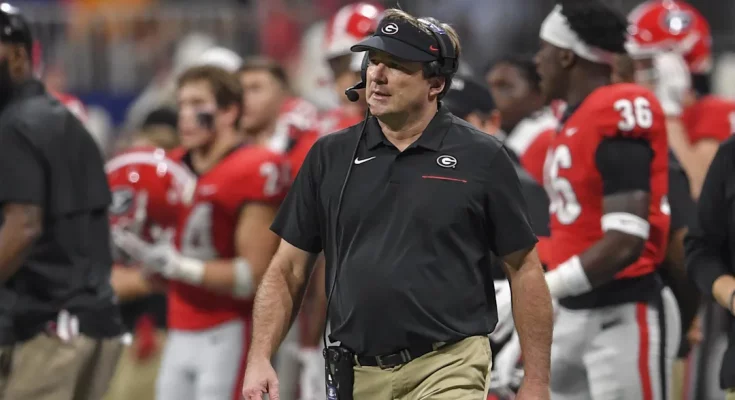In the modern age of college football, where name, image, and likeness (NIL) dollars, recruiting budgets, high-powered coaching staffs, and state-of-the-art facilities dominate the conversation, few programs have navigated the financial arms race quite like the Georgia Bulldogs. As projections roll in for the 2025 season, Georgia is poised to hold the title of the second most expensive team in all of college football—a nod not just to their elite status on the field, but also to the significant financial investment that powers the engine of one of the sport’s most dominant dynasties. The University of Georgia’s meteoric rise under head coach Kirby Smart has not been without its price. From massive coaching salaries and elite player development systems to the relentless pursuit of top-tier talent in recruiting, every dollar spent has had a purpose. In an era where financial muscle can serve as the lifeblood of a championship program, Georgia has shown the willingness—and capability—to open the checkbook in pursuit of sustained greatness. According to multiple sources, Georgia is projected to trail only one other program, likely Texas A\&M or Alabama, in total football-related expenditures for the 2025 season. While the final figures are still being tabulated, early estimates peg Georgia’s total financial output at just north of \$185 million. This includes spending across coaching salaries, recruiting expenses, facilities maintenance and upgrades, NIL collectives, player support services, nutrition, travel, and game day operations. For context, that figure would have made Georgia the most expensive team in college football just a few years ago. That rapid escalation in spending is a direct reflection of the arms race now defining the highest levels of the sport.
Kirby Smart’s contract extension in 2022 set the tone for Georgia’s financial future. The deal, worth more than \$110 million over 10 years, solidified Smart as one of the top-paid coaches in the country and sent a message to recruits, staff, and the college football world: Georgia was all-in. Add in the seven-figure salaries of top assistants like offensive coordinator Mike Bobo and defensive coordinator Glenn Schumann, and the Bulldogs’ coaching payroll alone is in the neighborhood of \$18 million annually. But the Bulldogs’ expenditures are not just about payroll. Georgia’s investment in facilities has been relentless and comprehensive. The recently completed \$80 million expansion of the Butts-Mehre Heritage Hall—home to the football team’s locker room, weight room, and meeting spaces—features NFL-grade technology, recovery suites, and customized player lounges. Add to that the program’s use of high-end GPS tracking, real-time performance analytics, and biomechanical engineering tools, and it’s clear that Georgia is at the cutting edge of player development. Each new dollar spent seems to have a measurable impact on Georgia’s ability to attract elite athletes and keep them performing at the highest level.
Recruiting is another key area where Georgia is allocating serious resources. In 2024 alone, Georgia’s recruiting expenses surpassed \$4 million—among the highest in the country—and included everything from private jet travel to immersive visit weekends that border on Hollywood-level productions. The Bulldogs continue to rank among the top three in national recruiting rankings year after year, with 2025 shaping up to be another top-tier class. Georgia’s financial muscle gives it a strategic advantage in ensuring that no stone goes unturned in the pursuit of future stars. The school has also been aggressive and creative in supporting players through the rapidly evolving NIL landscape. Georgia-affiliated NIL collectives are well-organized and flush with donor support, estimated to be generating more than \$20 million in annual athlete opportunities across all sports. Football, of course, takes the lion’s share. That means top athletes not only choose Georgia for its history, coaching, and development, but also for the financial empowerment that now plays a critical role in decision-making. With NIL rapidly shifting the recruiting terrain, Georgia’s deep pockets and well-structured NIL infrastructure help ensure it remains at the top of the food chain.
However, being the second most expensive team in college football isn’t just about the glitz and glamour. It’s about results—and Georgia has delivered. Since 2021, the Bulldogs have won two national championships, secured multiple SEC titles, and consistently finished among the top programs in key performance metrics such as defensive efficiency, offensive yards per play, and third-down conversion rate. That on-field success has not only justified the spending—it’s encouraged even more of it. For Georgia, spending money is not viewed as a risk. It’s an investment in a machine that continues to generate extraordinary returns. The program has also found ways to turn their spending into an advantage in player retention. While other elite teams battle constant roster churn due to the transfer portal, Georgia’s culture and investment in player experience have helped stabilize the roster. Between high-end nutrition programs, personalized academic and mental health services, and a comprehensive focus on player wellbeing, Georgia creates an environment where elite talent wants to stay and develop. That level of stability is invaluable in an era where team chemistry can vanish overnight.
Georgia’s climb to the top of the spending charts is also a testament to the strength of its donor base and the university’s willingness to prioritize football as its flagship brand. The Bulldog Nation is as passionate as any fanbase in the country, and it has stepped up repeatedly to fund the program’s ambitions. From the \$53 million indoor practice facility to the aforementioned expansions, the university has drawn from a well of enthusiastic support. Season ticket sales continue to hit records, and the program is bringing in tens of millions in revenue from merchandise, television contracts, and postseason appearances. Of course, being among the most expensive programs means Georgia must also deal with the pressure that accompanies high expectations. Every year is national championship or bust. Every loss is dissected, and every flaw becomes a national talking point. But under Kirby Smart, the Bulldogs have learned to embrace those expectations. They welcome the pressure because they believe their system—and their spending—has created a standard that is hard to match.
Critics may point to the growing commercialization of the sport, arguing that college football is losing its identity amid this money-driven revolution. But at Georgia, the counter-argument is simple: in a competitive landscape where margins are razor-thin, smart, strategic investment isn’t a luxury—it’s a necessity. The Bulldogs are not spending recklessly. They’re spending with purpose, guided by a clear vision of what championship football requires in today’s world. As the 2025 season approaches, Georgia is not shying away from its status as a financial heavyweight. The Bulldogs are leaning into it, using their resources to stay at the forefront of innovation, competitiveness, and sustained success. Whether it’s through enhanced player care, cutting-edge analytics, or top-dollar recruiting, every financial decision is designed to reinforce the program’s elite status. The arms race in college football is far from over, and Georgia is not just participating—they’re leading the charge.
With the sport continuing to evolve in real time, programs that fail to keep up financially risk being left behind. Georgia understands that better than most. They’ve made the necessary investments, built the infrastructure, and embraced the business of winning. Now, as the projected second most expensive team in the nation, the Bulldogs stand tall—not just as contenders, but as a blueprint for how to build and sustain a modern college football empire. Whether this investment leads to another national title in 2025 remains to be seen, but one thing is certain: Georgia won’t be outspent, outworked, or outmatched in its quest for gridiron glory. In Athens, the price of greatness is steep—but the Bulldogs have never blinked at the bill.



